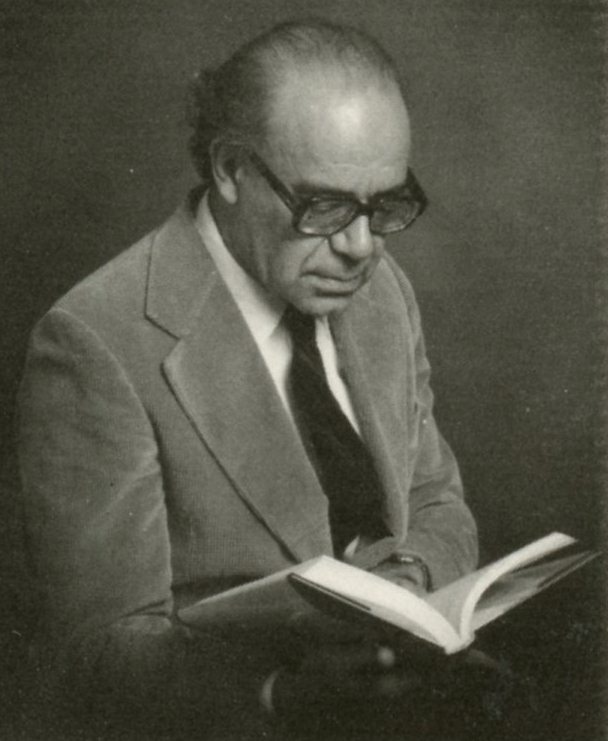
158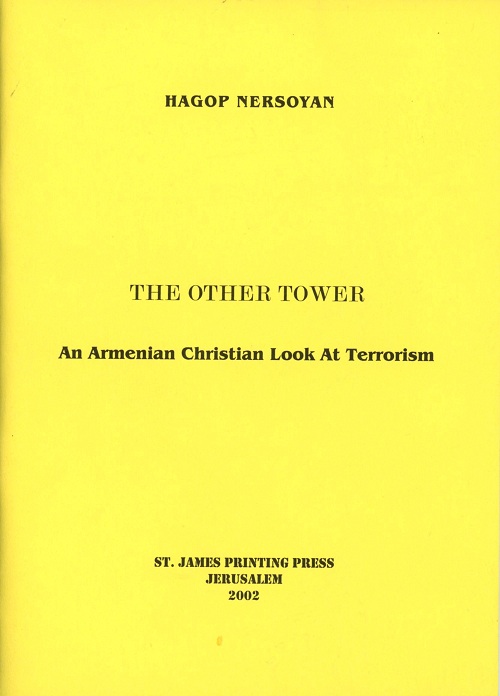 Rangement général
 | | The Other Tower - An Armenian Christian Look At Terrorism |
| Titre : | The Other Tower - An Armenian Christian Look At Terrorism / auteur(s) : Hagop NERSOYAN - |
|---|
| Editeur : | St. James Press |
|---|
| Année : | 2002 |
|---|
| Imprimeur/Fabricant : | Jerusalem |
|---|
| Description : | 14,5 x 20 cm, 66 pages |
|---|
| Collection : | |
|---|
| Notes : | |
|---|
| Autres auteurs : | |
|---|
| Sujets : | Armenian Church -- Views about Terrorism |
|---|
| ISBN : | |
|---|
| Lecture On-line : | non disponible |
|---|
Commentaire :Point of View:
It is no exaggeration to say that all Christian doctrine is a commentary on John 1:14: "And the Word [that was with God and that was God] was made flesh, and dwelt among us." All the major "heresies" are teachings that the catholic orthodox church regards as wrong interpretations of this verse. According to the Roman Catholic and Greek Orthodox Churches the verse is to be understood to mean that there are two natures, one divine, the other human, that were united in the Person of Jesus Christ, but without confusion, change, division or separation. The Armenian (Cyrillian) Church regards this formulation as a risky, even false way of putting it. Why? Because it may create an unbridgeable gap between the divinity and the humanity of Jesus Christ, and because it makes no room for the doctrine that God was crucified. The Armenian Church, in line with developments since Martin Luther that are critical of the Roman Catholic formula, upholds Cyril's preferred formulation: "One nature of the Word Incarnate." This is a less risky and more felicitous way of recognizing that Jesus Christ was both God and a human being.
According to the philosopher David Hume, everything we know is either an impression or an idea. An impression is a picture in my head, like that of a cup. An idea is something that I cannot visualize as I can visualize a cup. Justice, for example. Hume claimed that an idea that cannot be traced to an impression stands for nothing. Justice, for example, although an idea, does stand for something because I can trace it to just (visible) actions such as paying the right amount for something purchased.
But what does this piece of philosophy, which may not even be all that accurate, have to do with Cyrillian christology?
Hume's theory is interesting in this context because it explains something it was not his intention to explain. It explains the use of metaphors. We have a better grasp of an abstraction when we reduce it to something picturable. Trying to reduce to a picture in the mind the Armenian Church's claim that God becomes a human being without ceasing to be God, I will have recourse to a forcibly imperfect metaphor that I have used on previous occasions. I will dare say that for the purpose at hand we may compare the concept of God to the concept of ocean, and the concept of a human being to the concept of a floe of ice. We may then say that God becomes a human being in the world, without ceasing to be God, roughly in the manner of an ocean that becomes an unusual, pure floe of ice at the Antarctica, without ceasing to be ocean. It is also in this sense that God "sends" His only-begotten Son, inasmuch as God the Father and God the Son are, with God the Holy Spirit, the self-same one God. In the Armenian Church's understanding of the Incarnation there is no talk of natures in the plural. Jesus Christ is to be recognized in one nature which is both divine and human, as the floe of ice is both "ocean" and "floe" at the same time.
It is also useful to note that the Armenians, after the adoption of Christianity early in the fourth century at any rate, never engaged in any major aggressive war seeking to conquer or occupy other peoples' lands. |
157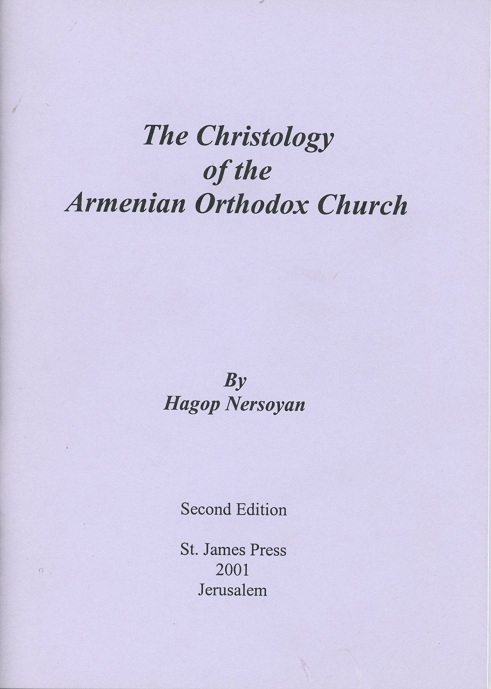 Rangement général
 | | The Christology of the Armenian Orthodox Church |
| Titre : | The Christology of the Armenian Orthodox Church / auteur(s) : Hagop NERSOYAN - |
|---|
| Editeur : | St. James Press |
|---|
| Année : | 2001 |
|---|
| Imprimeur/Fabricant : | Jerusalem |
|---|
| Description : | 12 x 17 cm, 22 pages |
|---|
| Collection : | |
|---|
| Notes : | Second edition |
|---|
| Autres auteurs : | |
|---|
| Sujets : | Armenian Church -- Christology -- Ecumenism |
|---|
| ISBN : | |
|---|
| Lecture On-line : | non disponible |
|---|
Commentaire :In its February, 2000, issue Outreach, a periodical published in New York by the Armenian Prelacy, printed an article by Professor Vigen Guroian on the Joint Declaration signed by Karekin I and John Paul II in December, 1996, in Rome.
Prompted by this article Professor Hagop Nersoyan presents a philosophical defense of the position of the Armenian Church regarding the nature(s) of Jesus Christ. Guroian's article is reproduced below (as is, except for the correction of some obvious typographical errors), followed byNersoyan's comments. |
156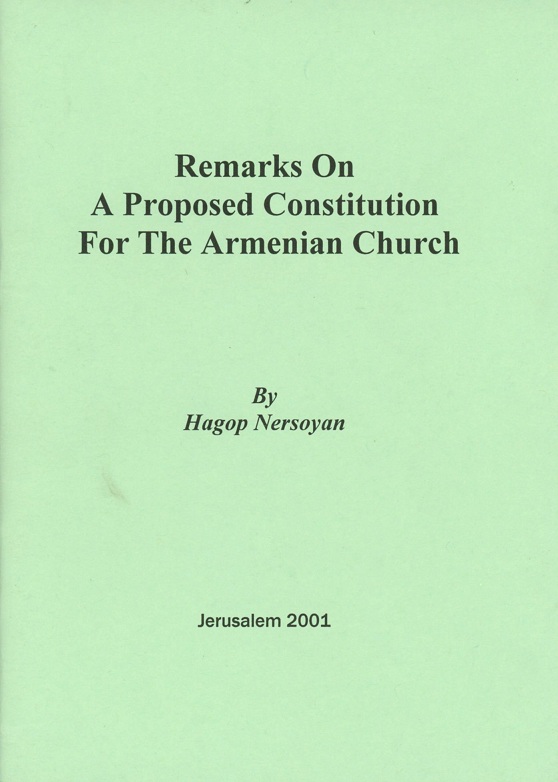 Rangement général
 | | Remarks On A Proposed Constitution For the Armenian Church |
| Titre : | Remarks On A Proposed Constitution For the Armenian Church / auteur(s) : Hagop NERSOYAN - |
|---|
| Editeur : | St. James Press |
|---|
| Année : | 2001 |
|---|
| Imprimeur/Fabricant : | Jerusalem |
|---|
| Description : | 12 x 16,5 cm, 40 pages |
|---|
| Collection : | |
|---|
| Notes : | |
|---|
| Autres auteurs : | |
|---|
| Sujets : | Armenian Church -- Constitution |
|---|
| ISBN : | |
|---|
| Lecture On-line : | non disponible |
|---|
Commentaire :Revised version of an earlier article. The argument is developed more fully in a more extensive Armenian text. |
159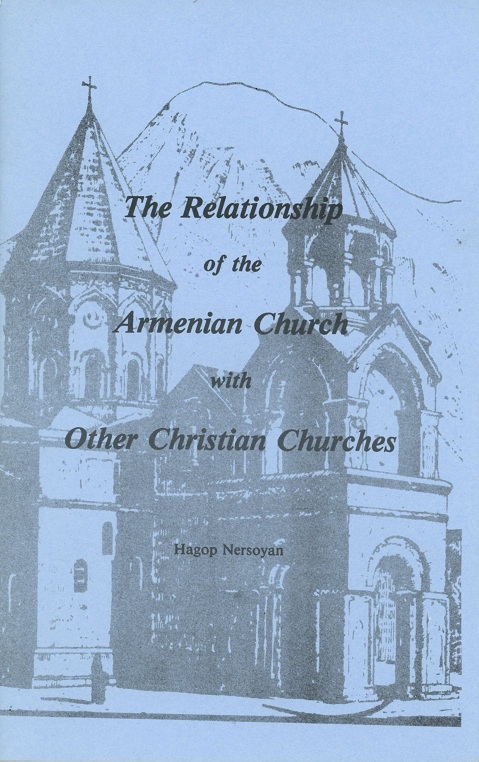 Rangement général
 | | The Relationship of the Armenian Church With the Other Christian Churches |
| Titre : | The Relationship of the Armenian Church With the Other Christian Churches / auteur(s) : Hagop NERSOYAN - |
|---|
| Editeur : | Diocese of Canada |
|---|
| Année : | 1998 |
|---|
| Imprimeur/Fabricant : | Montreal |
|---|
| Description : | 14 x 21 cm, 30 pages |
|---|
| Collection : | |
|---|
| Notes : | Bilingual Armenian-English |
|---|
| Autres auteurs : | |
|---|
| Sujets : | Ecumenical -- Conference |
|---|
| ISBN : | |
|---|
| Lecture On-line : | non disponible |
|---|
Commentaire :I am using the word 'relationship' in our title partly to mean the attitude of the Armenian Church toward non-Armenian Churches. This attitude is both fashioned by, and expresses itself through, events that make up the history and determine the tradition of our Church. It also testifies to the light that God has given us to discern truth from error. It goes without saying that relationship also implies similarities and differences. Of the similarities between the Armenian Church and other Churches, as well as of its difference from them we shall speak shortly. Why
Having defined an important word in the formulation of our subject, we can ask quite pertinently the following: Why should the study of such a question be of interest at all?
Different people may have different reasons for wanting to know about the differences and similarities of the Armenian Church from and with other Churches. Some may have pride in their Church and may want to substantiate this pride with facts. Others may feel uneasy either in our Church or simply in a plurality of Churches and may be looking for one that would suit them better or best. Still others may want to know about our relationship with other Churches out of plain scientific curiosity.
All of these reasons are legitimate. There is, however, a fourth reason — a psychological one — that makes people ask frequently about the place of our Church in the multitude of Churches that exist in this country. It makes no difference, they are led to think, whether you belong to this Church or that.
These men and women ask the question because they do not really belong to their own Church in the first place. They are indifferent spectators of all Churches including their own. And the question, 'What are the differences?' is merely a substitute in their minds for the interjection, 'What's the difference!' And it is worthy of note, in this connection, that whereas clergymen are asked again and again, in this country, to clarify points of differences to 'interested* audiences, it occurs to relatively fewer people to ask such a question in more compact Armenian communities elsewhere.
The Basic Difference
I will say in a moment what some of the things are that distinguish our Church from other Churches. But these will be only the expressions of the basic identity of our Church, that comes to the fore when it is considered in contrast to other Churches. Its basic difference, therefore, is its being this particular Church. As far as we, you and I, are concerned, it is 'different' because it is our Church, whereas the others are not. An example may clarify this obscure saying: suppose someone asks you all of a sudden, 'What are your differences from other persons?' At first you would be baffled. Then you would begin to compare yourself with people you know. You would eventually be able to point out a great many differences, but always with a sense of not having exhausted the list of the things that make you a different person. And it is this difference that at the same time relates you to other people. There are people with whom you are friendly, others with whom you are not so friendly. Still others whose existence does not affect your life in any visible fashion.
There are Churches that hold with us the same truths, Churches that refuse to do so, and other organized communities that have not heard, or do not care to listen to our message. It is these circumstances that determine our attitude toward, or relationship with them.
I am asked to give you this afternoon a panoramic view of the Christian Churches and to place the Armenian Church in this general picture. There was a time when I myself was satisfied with knowing that my Church was mine, and that it was the true Church. This opinion is however, not satisfactory to the extent to which national consciousness loses its grip on our minds. Be that as it may, the fact remains that in spite of its being that of a now small people, the Armenian Church tradition is sound and solid enough to stand proudly, shining with truths, even when it is taken apart for purposes of comparative study.
|
153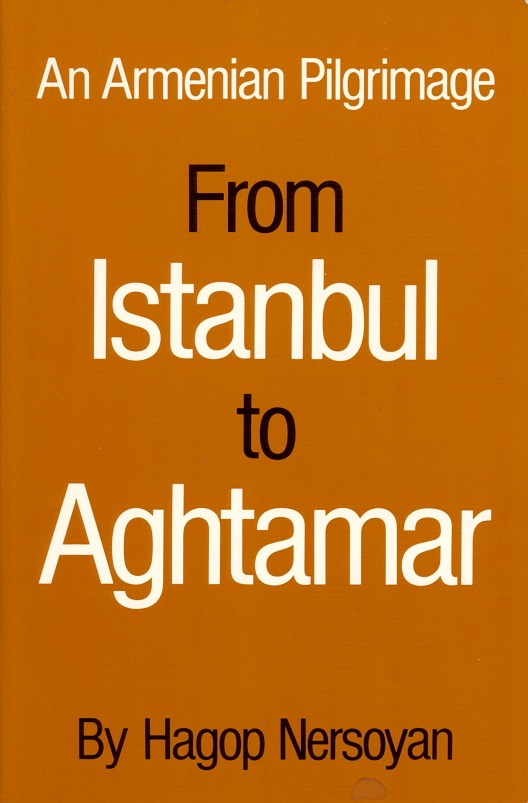 Rangement général
 | | An Armenian Pilgrimage: From Istanbul to Aghtamar |
| Titre : | An Armenian Pilgrimage: From Istanbul to Aghtamar / auteur(s) : Hagop NERSOYAN - |
|---|
| Editeur : | Ashod Press |
|---|
| Année : | 1990 |
|---|
| Imprimeur/Fabricant : | New York |
|---|
| Description : | 15 x 23 cm, 98 pages |
|---|
| Collection : | |
|---|
| Notes : | |
|---|
| Autres auteurs : | |
|---|
| Sujets : | Récit de voyage |
|---|
| ISBN : | 0935102272 |
|---|
| Lecture On-line : | non disponible |
|---|
Commentaire : |
|
